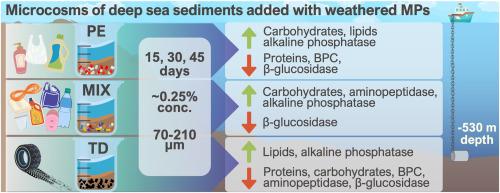Weathered microplastics alter deep sea benthic biogeochemistry and organic matter cycling: insights from a microcosm experiment
IF 7.3
2区 环境科学与生态学
Q1 ENVIRONMENTAL SCIENCES
引用次数: 0
Abstract
The deep seafloor is the largest reservoir for plastic contamination; yet, it remains unclear whether Carbon introduced through synthetic polymers might alter key ecosystem functions. We assessed the potential alterations in organic matter (OM) cycling triggered by a pulse-injection of microplastics (MPs) into deep sea sediments collected from the upper bathyal zone at 530 m depth. Sediments were exposed for 15, 30 and 45 days to environmentally relevant concentrations (∼0.25 % in weight) of naturally weathered MPs (size range 70–210 μm) of polyethylene, tyre wear particles, and a mixture of polymers. Weathered MPs significantly affected the semi-labile fractions of sedimentary OM and extracellular enzymatic activities, ultimately impairing carbon degradation and turnover rates. Polymer-specific effects were observed in carbohydrate and lipid contents, as well as in the activities of alkaline phosphatase and β-glucosidase, with tyre wear particles exerting the most intense impact. Notably, the polymer mixture triggered a less intense effect compared to the same concentration of single polymers. This study highlights how MP contamination can disrupt biogeochemical cycles in deep-sea soft bottoms. Given that these ecosystems constitute the largest portion of the oceans’ seafloor, impacts here documented may signal possible cascading effects throughout the ecological hierarchy. Further research is needed to fully understand the dynamics and effects triggered by substantial accumulation of plastic-derived Carbon in these ecosystems.


风化微塑料改变深海底栖生物地球化学和有机物循环:来自微观世界实验的见解
深海是塑料污染的最大储存库;然而,尚不清楚通过合成聚合物引入的碳是否会改变关键的生态系统功能。我们评估了将微塑料(MPs)脉冲注射到530米深的深海沉积物中所引发的有机物(OM)循环的潜在变化。沉积物分别暴露于环境相关浓度(约0.25%重量)的天然风化MPs(粒径范围70-210 μm)、聚乙烯、轮胎磨损颗粒和聚合物混合物中15、30和45天。风化MPs显著影响沉积OM的半不稳定组分和细胞外酶活性,最终损害碳降解和周转率。聚合物对碳水化合物和脂质含量、碱性磷酸酶和β-葡萄糖苷酶活性均有特异性影响,其中轮胎磨损颗粒的影响最为强烈。值得注意的是,与相同浓度的单一聚合物相比,聚合物混合物引发的效应不那么强烈。这项研究强调了MP污染如何破坏深海软底的生物地球化学循环。鉴于这些生态系统构成了海洋海底的最大部分,这里记录的影响可能预示着整个生态等级可能产生的级联效应。需要进一步的研究来充分了解这些生态系统中塑料衍生碳的大量积累所引发的动态和影响。
本文章由计算机程序翻译,如有差异,请以英文原文为准。
求助全文
约1分钟内获得全文
求助全文
来源期刊

Environmental Pollution
环境科学-环境科学
CiteScore
16.00
自引率
6.70%
发文量
2082
审稿时长
2.9 months
期刊介绍:
Environmental Pollution is an international peer-reviewed journal that publishes high-quality research papers and review articles covering all aspects of environmental pollution and its impacts on ecosystems and human health.
Subject areas include, but are not limited to:
• Sources and occurrences of pollutants that are clearly defined and measured in environmental compartments, food and food-related items, and human bodies;
• Interlinks between contaminant exposure and biological, ecological, and human health effects, including those of climate change;
• Contaminants of emerging concerns (including but not limited to antibiotic resistant microorganisms or genes, microplastics/nanoplastics, electronic wastes, light, and noise) and/or their biological, ecological, or human health effects;
• Laboratory and field studies on the remediation/mitigation of environmental pollution via new techniques and with clear links to biological, ecological, or human health effects;
• Modeling of pollution processes, patterns, or trends that is of clear environmental and/or human health interest;
• New techniques that measure and examine environmental occurrences, transport, behavior, and effects of pollutants within the environment or the laboratory, provided that they can be clearly used to address problems within regional or global environmental compartments.
 求助内容:
求助内容: 应助结果提醒方式:
应助结果提醒方式:


